Quarter Isogrid Prior Art Gallery
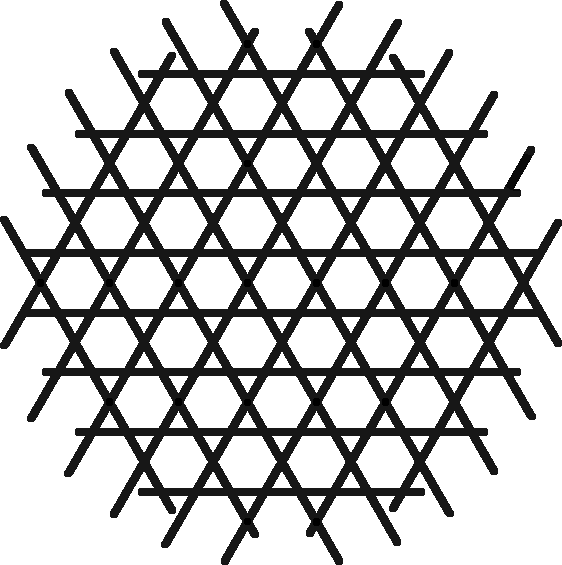
"quarter isogrid" is an array of hexagons and triangles
Examples of historic uses of a geometric pattern called "quarter isogrid", consisting of an array of triangles and hexagons, that would seem to have many structual applications, but has somehow remained obscure. (Or maybe it's everywhere and I've missed it. Send examples.)
Weave Patterns
I'm most interested in finding examples where the quarter isogrid is used in a structure where conventional isogrid, honeycomb, or square grid would be more common. Woven goods are not the kinds of applicationss I'm most interested in, but the pattern does appear more readily and spontaneously in this realm. A few examples:
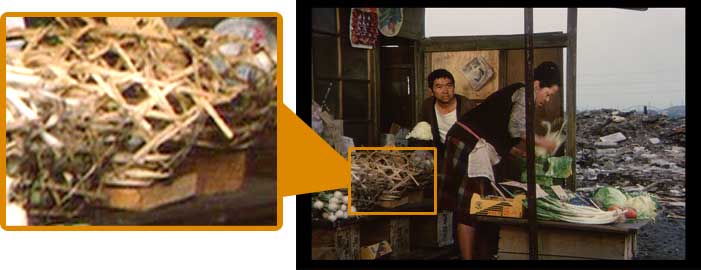
Basket Weave
I've been told there's an Amish (or was it Shaker?) basket weave pattern that makes the same array of triangles and hexagons. But I don't think we need to assign it to any one tradition or object. It's just a pattern that can be woven.
I couldn't find any basket examples online, but while watching a Japanese movie, I spotted some produce baskets demonstrating the quarter isogrid pattern. Frame grab and magnification above taken from "Dodes'ka Den", directed by Akira Kurosawa, released in 1970.
Caning
You might consider the quarter isogrid pattern as a component of some caning patterns, though it's generally supplemented and obscured by other sets of lines. It seems to be an unavoidable result rather than an intentional building block of some of these complex weave patterns.
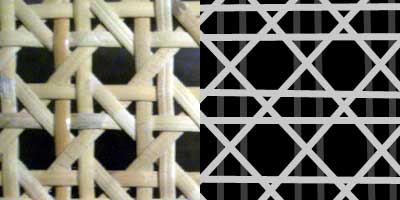 Conventional caning can be seen as a quarter isogrid pattern, with non-uniform spacing between one of the three sets of lines, supplemented by a fourth set of parallel lines with the same non-uniform spacing.
Conventional caning can be seen as a quarter isogrid pattern, with non-uniform spacing between one of the three sets of lines, supplemented by a fourth set of parallel lines with the same non-uniform spacing.
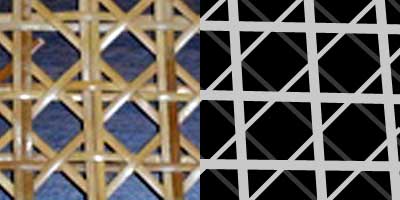 Diamond caning can be seen as a skewed quarter isogrid pattern, supplemented by a fourth set of parallel lines.
Diamond caning can be seen as a skewed quarter isogrid pattern, supplemented by a fourth set of parallel lines.
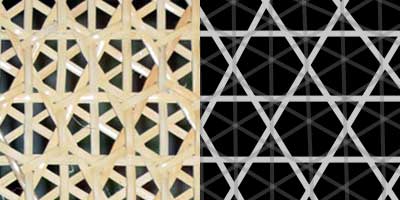 Spider web caning can be seen as the quarter isogrid pattern superimposed on the conventional isogrid pattern.
Spider web caning can be seen as the quarter isogrid pattern superimposed on the conventional isogrid pattern.
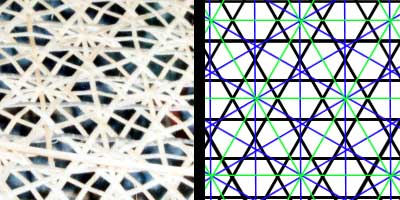 Star of David caning is a quarter isogrid, combined with two conventional isogrid patterns of different scale and orientation. It's a real tangle of lines that serve to fill in the triangles and one out of four of the quarter isogrid hexagons, to emphasize the stellated hexagon.
Star of David caning is a quarter isogrid, combined with two conventional isogrid patterns of different scale and orientation. It's a real tangle of lines that serve to fill in the triangles and one out of four of the quarter isogrid hexagons, to emphasize the stellated hexagon.
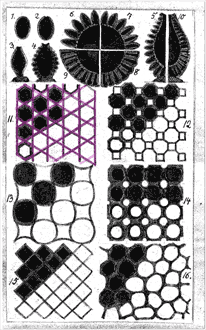
Ernst Haeckel, circa 1870
(or, sponge, circa eons ago)
In Ernst Haeckel's wonderful illustrations of sea life, both macroscopic and microscopic, Jan Seiler has found, and forwarded to me, at least one example where Haeckel explicitely sketches the quarter isogrid pattern, as one of many "crystal shapes" in calcareous sponges.
This sketch appears in Visions of Nature: The Art And Science of Ernst Haeckel.
I had hoped to find the pattern in Haeckel's illustrations of radiolaria, which I remembered first seeing as a poster in kindergarten. The collections of his illustrations I found online didn't seem to reveal the pattern, but I wouldn't be surprised if the pattern showed up again, deeper in the slightly less photogenic depths of that collection, or elsewhere in his work.



 Conventional caning can be seen as a quarter isogrid pattern, with non-uniform spacing between one of the three sets of lines, supplemented by a fourth set of parallel lines with the same non-uniform spacing.
Conventional caning can be seen as a quarter isogrid pattern, with non-uniform spacing between one of the three sets of lines, supplemented by a fourth set of parallel lines with the same non-uniform spacing.
 Diamond caning can be seen as a skewed quarter isogrid pattern, supplemented by a fourth set of parallel lines.
Diamond caning can be seen as a skewed quarter isogrid pattern, supplemented by a fourth set of parallel lines.
 Spider web caning can be seen as the quarter isogrid pattern superimposed on the conventional isogrid pattern.
Spider web caning can be seen as the quarter isogrid pattern superimposed on the conventional isogrid pattern.
 Star of David caning is a quarter isogrid, combined with two conventional isogrid patterns of different scale and orientation. It's a real tangle of lines that serve to fill in the triangles and one out of four of the quarter isogrid hexagons, to emphasize the stellated hexagon.
Star of David caning is a quarter isogrid, combined with two conventional isogrid patterns of different scale and orientation. It's a real tangle of lines that serve to fill in the triangles and one out of four of the quarter isogrid hexagons, to emphasize the stellated hexagon.
